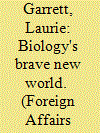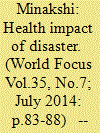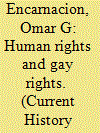|
|
|
Sort Order |
|
|
|
Items / Page
|
|
|
|
|
|
|
| Srl | Item |
| 1 |
ID:
124636


|
|
|
|
|
| Publication |
2013.
|
| Summary/Abstract |
In May 2010, the richest, most powerful man in biotechnology made a new creature. J. Craig Venter and his private-company team started with DNA and constructed a novel genetic sequence of more than one million coded bits of information known as nucleotides. Seven years earlier, Venter had been the first person in history to make a functioning creature from information. Looking at the strings of letters representing the DNA sequence for a virus called phi X174, which infects bacteria, he thought to himself, "I can assemble real DNA based on that computer information." And so he did, creating a virus based on the phi X174 genomic code. He followed the same recipe later on to generate the DNA for his larger and more sophisticated creature. Venter and his team figured out how to make an artificial bacterial cell, inserted their man-made DNA genome inside, and watched as the organic life form they had synthesized moved, ate, breathed, and replicated itself.
|
|
|
|
|
|
|
|
|
|
|
|
|
|
|
|
| 2 |
ID:
129203


|
|
|
|
|
| Publication |
2014.
|
| Summary/Abstract |
The Global Fund to Fight AIDS, Tuberculosis, and Malaria is one of the world's largest funders of global health programs. From 2002 to 2011, the Global Fund disbursed about US$15.5 billion to support programs aiming to prevent and treat the three diseases, to care for the people suffering from them, and to strengthen health systems in more than 150 low- and middle-income countries. At its replenishment meeting this December, the Global Fund pledged $12 billion to supporting programs through 2016. Yet, while the Global Fund has made important contributions to the fight against AIDS, tuberculosis, and malaria over the past decade, each year over 3 million people still die from these three diseases. Millions more suffer from extended periods of sickness. Only about half of people eligible for anti-retroviral (ARV) medicines in developing countries actually enroll in treatment. It is therefore worth remembering that the same moral imperative that drove the creation of the Global Fund over a decade ago also compels the Fund and its partners to do whatever they can to ensure that the billions of dollars the Fund raises and disburses reduce the disease burden as efficiently as possible
|
|
|
|
|
|
|
|
|
|
|
|
|
|
|
|
| 3 |
ID:
132500


|
|
|
|
|
| Publication |
2014.
|
| Summary/Abstract |
Gender and Health Issues in Disaster: Disasters are traumatic events that are experienced by many
people and may result in a wide range of mental and physical health consequences (Norris, Friedman,
Watson, et al., 2002). The resulting impacts from disasters are frequently more severe on women and
girls than those of their male counterparts and women's physical, reproductive and mental health needs, along with other facets of women's lives,.have largely been ignored in the whole process (Laska et al., 2008). According to WHO, there is pattern of gender differentiation at all level of disaster process: exposure ' to risk, risk perception, preparedness, response, physical impact, psychological impact, recovery and reconstruction and there is evidence showing that women and men may sufferdifferent negative health consequences after the disaster (WHO, 2002). However, it is not clear whether this is due to biological differences between the sexes, because of socially determined differences in women's and men's roles and status or because of the interaction of social and biological factors (WHO, 2002).
|
|
|
|
|
|
|
|
|
|
|
|
|
|
|
|
| 4 |
ID:
127590


|
|
|
|
|
| Publication |
2014.
|
| Summary/Abstract |
Over the past 100 years, global demographic changes have been more than just historic - they have been so sweeping and profound as to rank almost on the scale of an evolutionary leap. What we have witnessed is nothing less than a departure from the demographic rhythms that previously characterized human existence. Across the world we have seen humanity unshackled from practically all the patterns and limits that bound us before, save for reproduction and death itself.
|
|
|
|
|
|
|
|
|
|
|
|
|
|
|
|
| 5 |
ID:
127588


|
|
|
|
|
| Publication |
2014.
|
| Summary/Abstract |
When, many years from now, historians undertake to determine the watershed moments in the evolution of the international human rights movement, they likely will single out for attention the June 2011 United Nations Human Rights Council (UNHRC) resolution affirming that "gay rights are human rights." A simple fact underscores the resolution's momentousness: It has become common to think of gay rights and human rights as closely intertwined, yet the 1948 Universal Declaration of Human Rights-which asserted that human rights are inalienable rights that a person is entitled to simply because he or she is a human-made no mention of sexual identity, even as it addressed a wide range of rights, such as the right to work, housing, education, association, religion, and even leisure. So how did this commingling of human rights and gay rights come about, and what does it say about the future of both movements?
|
|
|
|
|
|
|
|
|
|
|
|
|
|
|
|
| 6 |
ID:
134146


|
|
|
|
|
| Publication |
2014.
|
| Summary/Abstract |
This article analyses the emergency governance of international organizations by combining securitization theory with legal theory on the state of exception. Our main argument is that where issues are securitized as global threats, exceptionalism can emerge at the level of supranational bodies, endowing them with the decisionist authority to define emergencies and guide political responses. We theorize the 'emergency trap', which is triggered when the emergency powers of international organizations reduce the obstacles to, and increase the incentives for, the securitization of further issues. Based on the idea that the emergency trap functions as an institutional driver of securitization, we also highlight the importance of the constitutional containment of emergency competencies as an alternative to discursive desecuritization strategies. We illustrate this security-emergency dynamic in a case study of the recent empowerment of the World Health Organization (WHO) in the governance of global health emergencies. The article shows how WHO's exceptional response to the 2003 severe acute respiratory syndrome (SARS) crisis paved the way for an institutionalization of emergency powers within the organization and contributed to securitizing the 2009 swine influenza outbreak as a global pandemic. However, WHO's crisis governance has also triggered internal and external processes of constitutional contention.
|
|
|
|
|
|
|
|
|
|
|
|
|
|
|
|
|
|
|
|
|